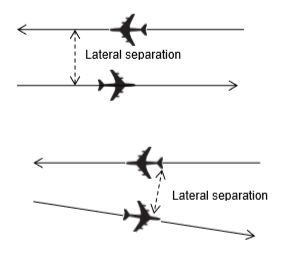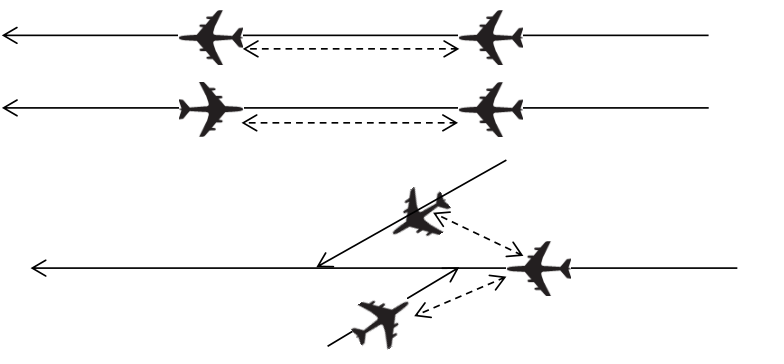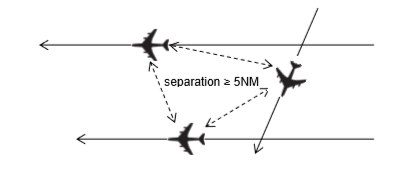¶ Introduction
When flying IFR inside controlled airspace, air traffic controllers either providing a service to an aircraft under their control or to another controller's traffic, have a duty to provide a separation above the minimum standard separation between the subject and other aircraft.
This document will present the IFR separation when an ATS surveillance system is used (radar) in the provision of area control service and approach control service.
This document is not meant for aerodrome control service.
¶ Rules
An air traffic controller shall avoid the loss of separation all the time by providing adequate instructions or clearances in order to keep separation of all aircraft in his airspace with all other aircraft (in his airspace or not) above the applicable minimum standard separation in the airspace concerned.
No clearance shall be given to execute any manoeuvre that would reduce the spacing between 2 aircraft to less than the separation minimum.
Larger separation than the specified minima should be applied whenever exceptional circumstances such as unlawful interference or navigational difficulties call for extra precaution.
This should be done with due regard to all relevant factors and the air traffic controller shall pay attention to not entering into application of excessive separation logic.
¶ Definition
¶ Types of separation
There are 2 main types of separation:
- Vertical separation
- Horizontal separation
¶ Vertical separation
Vertical separation is obtained by requiring aircraft to use prescribed altimeter settings procedures to operate at different levels in terms of flight level or altitude.

¶ Horizontal separation
There are two types of horizontal separation:
- Lateral separation

- Longitudinal separation

¶ Composite separation
A composite separation is a term which can be used when applying a combination of horizontal separation and vertical separation.
¶ Controlled Airspace
IFR traffic shall be separated:
- Between IFR flights in class A, B, C, D or E airspace
- Between IFR flights and VFR flights in class C, D or E airspace
- Between IFR flights and special VFR flights when prescribed by national regulations
- Between special VFR flights when prescribed by national regulations
¶ Separation criteria
2 aircraft can be considered separated if a minimum of one type of separation is established.
| Vertical separation | Horizontal separation | Aircraft are separated? |
|---|---|---|
| Below minimum | Below minimum | No |
| At or above minimum | Below minimum | Yes |
| Below minimum | At or above minimum | Yes |
| At or above minimum | At or above minimum | Yes |
¶ Loss of separation
When a type of separation or minimum used to separate 2 aircraft cannot be maintained, another type of separation and/or another minimum shall be established prior to the time when the current separation minimum would be infringed.
For an air traffic controller, this means that he must anticipate the loss of separation and provide instruction or clearance in order to maintain the separation above the minimum all the time using one or another type of separation.
¶ Vertical Separation
Vertical separation is obtained by requiring aircraft to use prescribed altimeter settings procedures to operate at different levels expressed in terms of flight levels or altitudes.
¶ Vertical separation minimum - VSM
The vertical separation minimum (VSM) is 300m (1000ft) below FL290 and 600m (2000ft) above FL290.
For the airspace where reduced vertical separation minimum (RVSM) is applicable, the separation minimum is 300m (1000ft) below FL410 and 600m (2000ft) above FL410.
Please consult the RVSM article to have more information about these regulations. RVSM is applicable all around the world at 95% coverage. The exception concerns some old non-RVSM civil aircraft (DC7/DC8...) and some military or state aircraft.
¶ Assignment of cruising levels for controlled flights
An aircraft may be cleared to change cruising level at a specified time, place or rate. The cruising flight level shall be selected from the available list of usable flight levels respecting the semi-circular rules.
Please consult the semi-circular rules article to have such list of available flight levels.
Except when traffic conditions and coordination procedures permit authorization of cruise climb, an ATC unit shall normally authorize only one level for an aircraft beyond its controlled area.
It is the responsibility of the accepting ATC unit to issue clearance for further climb as appropriate
In so far as applicable, cruising levels of aircraft flying to the same destination shall be assigned in a manner that will be correct for an approach sequence at destination.
An aircraft at a cruising flight level shall normally have priority over other aircraft requesting that cruise level. When 2 or more aircraft are at the same cruising level, the preceding aircraft shall normally have priority
¶ Climbing and descending to previously assigned levels
An aircraft may be cleared to a level previously occupied by another aircraft after the level is vacated except when:
- Severe turbulence is known to exist
- The higher aircraft is executing a cruise climb
- The difference in aircraft performance is such that less than the applicable separation minimum may result.
Such a clearance shall be withheld until the aircraft vacating the level has reported at or passing another level separated by the required minimum.

In the example above, the lower aircraft can now receive the clearance as the vertical separation minimum is reached between the next aircraft new level and future aircraft level.
When the aircraft concerned is entering or established in the same holding pattern, consideration shall be given to aircraft descending at markedly different rates and specifying a maximum descent rate for the higher aircraft and minimum descent rate for the lower aircraft should be applied to ensure minimum separation.

In the example above, the upper aircraft is descending with a greater vertical speed rate than the other aircraft below. The vertical separation minimum will be infringed.
¶ Horizontal Separation
¶ Default horizontal separation minimum
The horizontal separation minimum based on radar and/or ADS-B shall be 5NM (9.3km).

¶ Reduced horizontal separation minimum
The radar separation minimum may be reduced to 3NM (5.6km) when radar capabilities at a given location so permit.
Pay attention that this reduced separation can be used only by decision of the ATC coordinator of your division on selected airfields. Big airports equipped with modern radar can have sufficient precision to enable this reduced separation for the approach area.
¶ Separation minimum between succeeding aircraft on final approach track
The radar separation minimum may be reduced to 2.5NM (4.6km) between succeeding aircraft on final approach track within 10NM (18.5km) of the runway end when the following conditions are respected.

This 2.5NM reduced separation minimum may be applied when:
- The average runway occupancy time of landing aircraft is proven not to exceed 50 seconds
- Braking action is reported as good
- Runway occupancy times are not adversely affected by runway contaminants such as slush, snow or ice
- Radar system with appropriate range resolution and an update rate of 5 seconds or less on radar display
- The aerodrome controller is able to observe, visually or by means of surface movement radar the runway-in-use and associated exit and entry taxiways.
- Distance based wake turbulence separation minima is not greater than 2.5 NM.
- Aircraft approach speeds are closely monitored by the controller and when necessary adjusted so as to ensure that separation is not reduced below the minimum.
- Aircraft pilots have been made fully aware of the need to exit the runway in an expeditious manner whenever
- Procedures concerning the application of the reduced minimum are published in AIPs.
Pay attention that this reduced separation can be used only by decision of the ATC coordinator of your division on selected airfields.
¶ Separation minimum due to wake turbulence separation minima
The following distance-based wake turbulence separation minima shall be applied to aircraft being provided with an ATS surveillance service in the approach and departure phase of flight when:
- An aircraft is operating directly behind another aircraft at the same altitude or less than 1000ft (300m) below or,
- Both aircraft are using the same runway or parallel runway separated by less than 760m (2500ft) or,
- An aircraft is crossing behind another aircraft at the same altitude or less than 1000ft (300m) below.
| Succeeding Aircraft | preceding aircraft | Separation minima | |
|---|---|---|---|
| Heavy behind Heavy | NM / 7.4km | ||
| Medium behind Heavy | NM / 9.3km | ||
| Light behind Heavy | NM / 11.1km | ||
| Light behind Medium | NM / 9.3km | ||
| Heavy behind A380 | NM / 11.1km | ||
| Medium behind A380 | NM / 13km | ||
| Light behind A380 | 8 NM / 14.8km | ||
¶ Clearance to fly maintaining own separation while in visual meteorological conditions
When so requested by an aircraft and provided it is agreed by the pilot of the other aircraft, an ATC unit may clear a controlled flight, including departing and arriving flights, operating in airspace class D and E in visual meteorological conditions (VMC) during the hours of daylight to fly subject to maintaining own separation to one other aircraft and remaining in visual meteorological conditions.
When a controlled flight is so cleared, the following shall apply:
- The clearance shall be for a specified portion of the flight at or below 10000ft or 3050m, during climb and descent.
- The pilot of an IFR flight, on observing that conditions are deteriorating and considered that operation in VMC will become impossible, shall inform ATC before entering instrument meteorological conditions (IMC) and shall proceed in accordance with the alternative instructions given.
Note: for the duration of the clearance, separation from other aircraft by ATC is not provided.
- none
- ICAO Documentation 4444 - Air Traffic Management - 16th Edition 2016 - Chapter 5
- VID 150259 - Creation
- VID 150259 - Wiki integration
- VID 496402 - Wiki.js integration